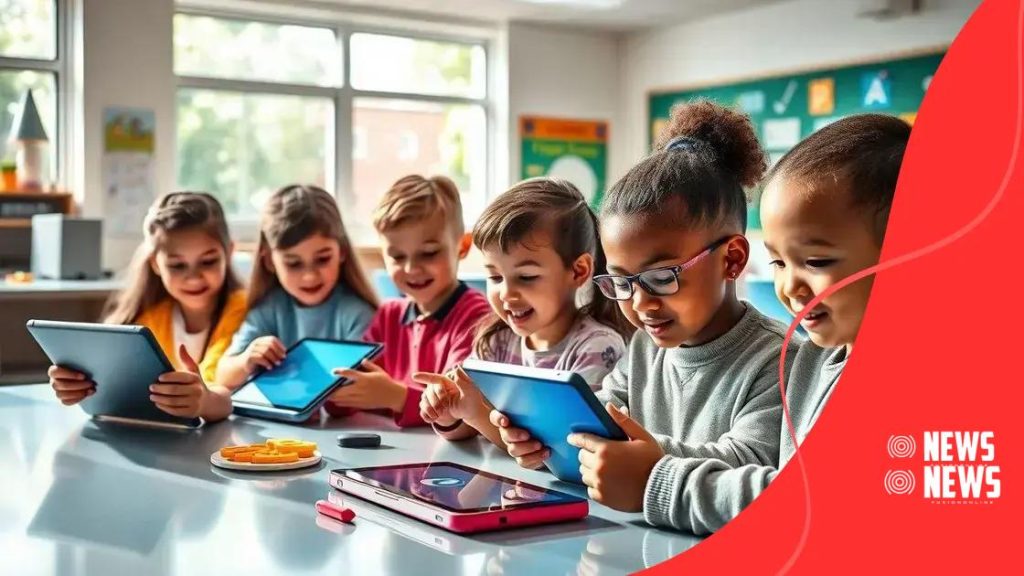Gamification in education: enhancing engagement effectively

Gamification in education enhances student engagement and retention by incorporating game-like elements, fostering collaboration, and providing immediate feedback, making learning more interactive and enjoyable.
Gamification in education is changing how students interact with learning materials. Have you ever thought about how game elements might motivate learners? Let’s explore its potential.
Understanding gamification and its principles
Understanding gamification is essential for effectively applying it in education. It combines the elements of game design with learning, making the process more engaging for students. Imagine learning math through a fun competition or reading comprehension as a thrilling quest!
Core principles of gamification
To grasp gamification, it’s helpful to know its core principles. These include:
- Motivation: Gamification taps into intrinsic motivation, encouraging students to learn.
- Feedback: Reward systems provide instant feedback, helping learners understand their progress.
- Challenge: Engaging challenges keep students interested and focused.
These elements foster a sense of accomplishment. When students achieve goals, they feel good about their progress. This can lead to a deeper understanding of the material, making it not just about grades but about learning.
Key elements of effective gamification
There are several key elements that make up effective gamification strategies:
- Leveling up: Allowing students to progress to different levels can create excitement and a sense of achievement.
- Badges and rewards: These incentives encourage students to perform better and engage more.
- Leaderboards: Healthy competition can motivate students, pushing them to excel.
Implementing these strategies helps create a thriving learning environment. Students want to participate and contribute, enhancing their overall educational experience. As they engage more, retention naturally improves, leading to a positive cycle of learning.
Benefits of gamification in education
Benefits of gamification in education are profound and wide-ranging. By incorporating game-like elements into learning, educators can create a more interactive and stimulating environment. Students who might struggle with traditional methods can find new excitement in their studies.
Enhanced engagement
One primary benefit is the increase in student engagement. Gamified learning methods make lessons more enjoyable. For instance, turning quizzes into a game can turn a mundane task into a thrilling challenge.
Improved retention
Another important advantage is improved retention of information. When students are actively involved in learning through games, they are more likely to remember what they’ve learned. Here are some key factors contributing to this:
- Active participation: Students remember information better when they participate actively.
- Immediate feedback: Game mechanics often provide instant feedback, reinforcing learning.
- Fun atmosphere: Learning in a fun way makes it easier to recall information later.
Furthermore, gamification encourages students to set personal goals. When learners earn points or rewards, they become motivated to reach higher achievements. This sense of accomplishment can boost their confidence and encourage further exploration of the subject matter.
Collaboration and teamwork
Gamification also promotes collaboration among students. Many gamified activities require teamwork, allowing peers to work together to solve problems. This builds communication skills and fosters a sense of community in the classroom. By participating in group challenges, students learn the importance of working with others toward a common goal.
Ultimately, the benefits of gamification in education extend beyond mere enjoyment. They lead to a deeper understanding of content and foster essential skills necessary for lifelong learning.
Examples of successful gamification in classrooms

Examples of successful gamification in classrooms showcase how innovative methods can transform learning experiences. Many teachers have adopted gamified strategies that not only engage students but also enhance their understanding of complex subjects. Let’s explore some effective examples.
Classroom competitions
One popular approach is to create classroom competitions. For instance, teachers may set up math challenges where students earn points for correct answers. As students compete for the highest scores, learning becomes a fun and competitive activity.
Interactive simulations
Another successful example is using interactive simulations. In science classes, educators might use digital simulations to explain ecological systems or chemical reactions. Students navigate through scenarios, making decisions that impact the outcome, which makes learning dynamic and engaging.
In history classes, role-playing games allow students to step into the shoes of historical figures. This not only helps them understand historical events but also encourages empathy and critical thinking.
Digital badges and rewards
Implementing digital badges has become increasingly common. Teachers award badges for completing tasks or mastering skills. This recognition motivates students to strive for more achievements. For example, in a literature class, students might earn badges for reading a certain number of books or participating in discussions.
- Example badge categories:
- Reading champion
- Math wizard
- Science explorer
These badges not only celebrate success but also build a sense of community among learners. Students proudly display their achievements, encouraging others to join in the fun.
Game-based learning platforms
Many educators utilize game-based learning platforms, such as Kahoot or Quizizz. These tools allow teachers to create quizzes that students answer in real-time using devices. The immediate feedback and competitive nature create an exciting learning environment.
The integration of these platforms has led to increased participation and improved test scores, proving that when students enjoy learning, they excel.
How to implement gamification strategies
How to implement gamification strategies involves several clear steps that teachers can follow to enhance learning. The process starts with setting clear goals and understanding what you want to achieve with gamification. By using game mechanics, educators can make lessons more engaging and fun for students.
Identify learning objectives
The first step is to identify the learning objectives. What skills do you want your students to develop? Consider both content knowledge and soft skills. Once you have defined these objectives, you can design activities that align with them. Making sure that the gamification strategies support the curriculum is essential.
Choose appropriate game elements
Next, choose the right game elements that will motivate students. Some popular elements include:
- Points: Award points for completing tasks, participating in class, or achieving milestones.
- Badges: Create digital badges to recognize specific achievements and encourage mastery.
- Leaderboards: Show rankings to foster a competitive spirit among students.
The right combination of these elements can create excitement and drive engagement in the classroom. For instance, using points and badges along with leaderboards can motivate students to participate actively in their learning.
Incorporate feedback mechanisms
Another key aspect is providing regular feedback to students. Gamification works best when students receive immediate feedback on their performance. Consider using quizzes with instant results or projects that allow peer review. This feedback helps students understand their progress and areas for improvement.
Foster a supportive environment
It’s also crucial to create a supportive environment where students feel safe to take risks. Emphasize that making mistakes is a part of learning. Encourage collaboration and teamwork during gamified activities. This promotes a sense of community among students, enhancing their learning experience.
Finally, reflect on the gamification process. After implementation, gather feedback from students to understand what worked well and what could be improved. Adjust your strategies accordingly so you can evolve and enhance the gamification experience for future classes.
Challenges and solutions in gamifying education
Challenges and solutions in gamifying education are important to consider for successful implementation. While gamification offers many benefits, educators often face obstacles that can affect effectiveness. Understanding these challenges allows teachers to develop strategies to overcome them.
Common challenges
One challenge is resistance from students who may prefer traditional learning methods. Some learners might view gamification as childish or not serious enough for academic work. This resistance can hinder engagement. Another significant issue involves the integration of technology. Not all classrooms have equal access to devices or reliable internet, which can limit the use of gamified tools.
- Student resistance: Some students may not be open to change.
- Technology access: Limited access to devices can create inequalities.
- Time constraints: Implementing gamification may require more planning and preparation.
Finding solutions
To address student resistance, educators can start by explaining the benefits of gamification. Sharing success stories from other students can help them see its value. Additionally, offering a range of activities can cater to different learning styles and preferences, ensuring everyone feels included.
For the technology access issue, teachers can consider offline options or low-tech alternatives. Activities like board games or paper-based tasks can still incorporate gamified elements while being accessible to all students. When it comes to time constraints, teachers should integrate gamification gradually. Start small by adding game elements to existing lessons, allowing it to become part of the routine.
Encouraging collaboration
Another solution is to encourage collaboration among students. Group activities can help break down resistance and foster a sense of community. When students work together, they can support one another in understanding the gamified experience.
Ultimately, recognizing and addressing these challenges allows educators to create a more effective and inclusive learning environment. By implementing thoughtful solutions, teachers can make gamification a valuable part of their teaching strategies.
Conclusion: Incorporating gamification into education can lead to exciting and engaging learning experiences for students. By understanding the benefits and overcoming challenges, educators can create a supportive and dynamic environment. With clear objectives, meaningful game elements, and a focus on collaboration, the classroom can become a place where learning is fun and effective. As teachers continue to experiment with gamification, they can inspire students to take ownership of their education and thrive in their learning journeys. 🌟
FAQ – Frequently Asked Questions about Gamification in Education
What are the primary benefits of gamification in education?
Gamification enhances student engagement, improves retention of information, and encourages collaboration among peers.
How can educators overcome resistance to gamification from students?
Educators can explain the benefits of gamification and share success stories to help students see its value and relevance.
What are some common challenges when implementing gamification?
Common challenges include student resistance, unequal access to technology, and the need for additional planning and preparation.
How can gamification be integrated into traditional teaching methods?
Gamification can be integrated gradually by incorporating game elements into existing lessons, making the transition smooth and engaging for students.





